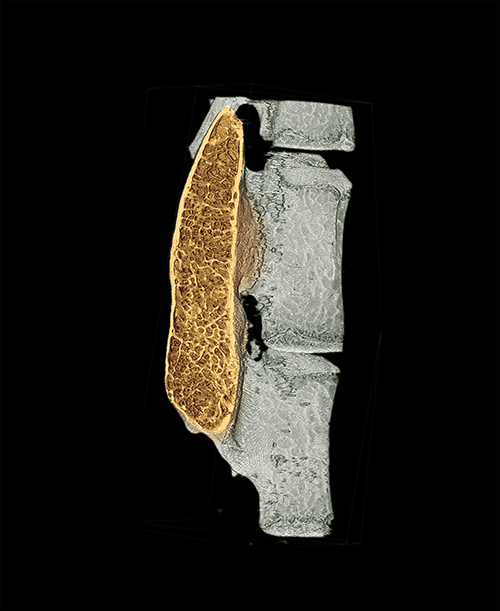
Northwestern University scientists discovered that a bioactive, biodegradable nanomaterial coated in sugar molecules can stimulate bone regeneration and may lead to better spinal fusion, according to findings published in the journal Nature Nanotechnology.
In an animal model, researchers studied the effect of sugar-coated nanomaterial on the activity of bone morphogenetic protein 2 (BMP-2). By incorporating the nanomaterial, which was delivered on a collagen sponge, they found that 100 times less BMP-2 was required for a successful fusion. The findings, they believe, could lead to less expensive technology to not only promote regeneration of bone but also muscle, tendons and cartilage throughout the body.


The colored region in a micro-CT image shows regenerated high-quality bone in the spine with minimal use of growth factor.
How is the nanomaterial designed? The team developed an artificial extracellular matrix to bind the protein in a way that compares to natural sugar binding in the body. The coated molecule is a synthesized sugar polymer known as sulfated polysaccharide, which resembles sugars used by nature to activate BMP-2 when cell signaling indicates bone growth. The sugar molecules on the surface of the nanostructure “grab” the protein in the spot used in biological systems to deploy the bone-growing signal. An important element of the matrix is that it slowly releases the sugar molecules instead of delivering in one early burst.
The Northwestern research team, led by Samuel I. Stupp, Ph.D., Director of the Simpson Querrey Institute of BioNanotechnology, Wellington K. Hsu, M.D., Associate Professor of Orthopaedic Surgery and Erin L. K. Hsu, Ph.D., Research Assistant Professor of Orthopaedic Surgery, plans to seek FDA approval to launch a human clinical trial studying the nanomaterial for bone regeneration.
Surgeons and hospitals are scrutinizing the cost of spinal implants and orthobiologics as one charge to patients, which has led to a desire for devices that produce better bone integration and fusion and rely on less biologics. While Northwestern’s technology is years from regulatory approval, early results are promising in that it reduces the amount of product needed, reduces cost to the system and can be translated into multiple uses throughout the body.
Source and Image: Northwestern University




